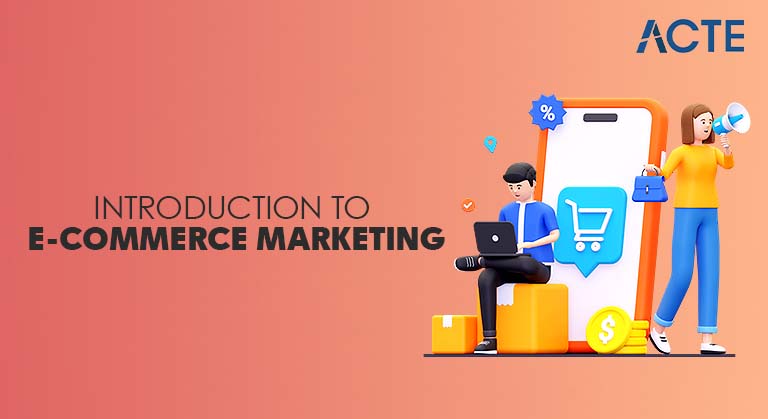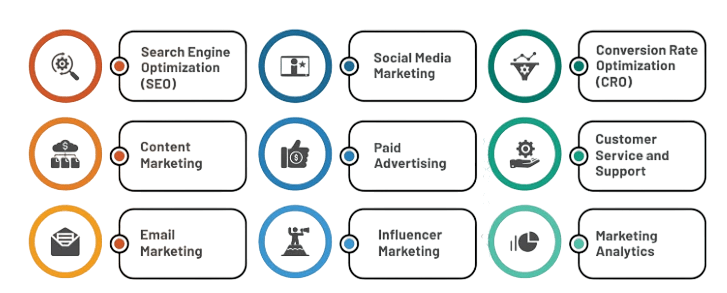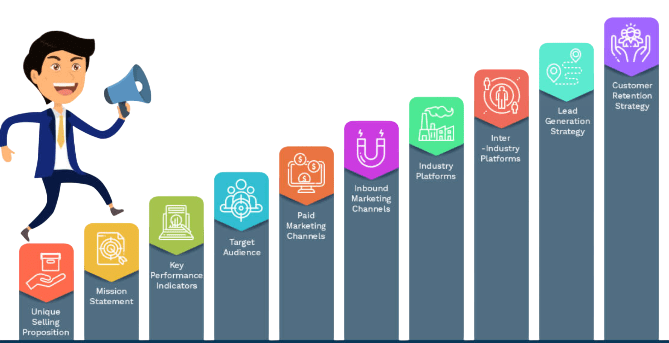
- What is E-commerce Marketing?
- Why is E-commerce Marketing Important?
- Types of E-commerce Marketing
- E-commerce Marketing Funnel
- E-commerce Marketing Strategy: Step-by-Step
- Examples of Successful E-commerce Marketing Campaigns
- Benefits of E-commerce Marketing
- Challenges in E-commerce Marketing
- Conclusion
What is E-commerce Marketing?
E-commerce marketing refers to the strategies and tactics used to drive traffic to your online store, convert visitors into paying customers, and retain those customers post-purchase .E-commerce marketing refers to the strategies and tactics businesses use to promote their online stores and drive sales through digital channels. It involves attracting potential customers to a website, engaging them with compelling content and offers, and encouraging purchases of products or services online. This includes a wide range of activities such as search engine optimization (SEO), pay-per-click (PPC) advertising, email marketing, social media campaigns, Digital Marketing Training influencer partnerships,Google Ads and content marketing. The goal of e-commerce marketing is to increase website traffic, improve conversion rates, build customer loyalty, and ultimately grow revenue in the digital marketplace. Unlike traditional marketing, e-commerce marketing is data-driven, scalable, and often automated using digital tools.
Ready to Get Certified in Digital Marketing? Explore the Program Now Digital Marketing Online Training Offered By ACTE Right Now!
Why is E-commerce Marketing Important?
The internet is saturated with online stores. Without a solid marketing plan, your site will likely remain invisible. E-commerce marketing is crucial because it directly influences the success and growth of online businesses in an increasingly competitive digital market place. With millions of online stores vying for attention, effective marketing strategies help businesses stand out, attract targeted traffic, Become a Digital Marketing Specialist and convert visitors into paying customers. Unlike traditional retail, e-commerce lacks physical interaction, making marketing efforts essential to build trust, communicate value, and guide customers through the buying journey. Additionally, e-commerce marketing allows businesses to reach a global audience 24/7, expanding their market beyond geographical boundaries. Through tactics like search engine optimization (SEO), social media advertising, email campaigns, and influencer collaborations, businesses can engage potential customers at different stages of their decision-making process. This targeted approach improves conversion rates, reduces customer acquisition costs, and increases return on investment (ROI). Furthermore, e-commerce marketing provides valuable insights through analytics, enabling businesses to understand customer behavior, preferences, and trends. This data-driven approach allows for continuous optimization and personalized experiences that foster customer loyalty and repeat purchases. In essence, e-commerce marketing is the backbone of online retail success, driving visibility, growth, and long-term profitability.
Types of E-commerce Marketing
Let’s dive into the core types of e-commerce marketing and how each plays a role in your strategy.
- SEO (Search Engine Optimization): SEO is about optimizing your website to rank higher in search engines like Google.
- Example: Optimizing product pages for terms like “organic skincare face cream” to appear on the first page of Google.
- Content Marketing: Content builds trust and engages users.Blog posts
- Pro Tip: Create a blog post titled “Best Hiking Backpacks for Summer 2025” to promote relevant products.
- Social Media Marketing: Platforms like Instagram, Facebook, and TikTok are goldmines for brand engagement TensorFlow.
- Example: Gymshark grew by leveraging fitness influencers and community-driven content on Instagram.
- Email Marketing: Email campaigns offer one of the highest ROIs.
- Tool Tip: Use Klaviyo or Mailchimp to automate personalized email flows.
- Pay-Per-Click (PPC): PPC involves paying for traffic through ads on platforms like Google Ads and Facebook Ads.
- Example: Amazon sellers often bid on competitor brand names to show their products in search results.
- Influencer Marketing: Partner with influencers to tap into niche audiences.Micro-influencers often have higher engagement rates and are more affordable.
- Affiliate Marketing: Let others promote your products for a commission.
- Retargeting: Only a small percentage of users convert on their first visit. Retargeting helps bring them back.
- Set Clear Goals: Establish measurable objectives such as increasing website traffic, boosting conversion rates, or growing email subscribers.
- Optimize Your Website: Ensure your site is user-friendly, mobile-responsive, fast-loading, and optimized for SEO to attract organic traffic.
- Create High-Quality Content: Develop engaging product descriptions, blog posts, videos, and guides that provide value and address customer needs.
- Leverage Social Media: Use platforms where your audience is active to build brand awareness, engage followers, SEO Keyword Research and drive traffic to your store.
- Implement Paid Advertising: Run targeted PPC campaigns on Google, Facebook, Instagram, or other platforms to attract qualified leads quickly.
- Build an Email List: Capture visitor emails with lead magnets and nurture subscribers through personalized email marketing campaigns.
- Use Influencer Marketing: Partner with influencers to reach new audiences and build trust through authentic endorsements.
- Offer Promotions and Discounts: Use limited-time offers, coupon codes, and flash sales to incentivize purchases and boost sales.
- Analyze and Optimize: Regularly review analytics data to measure performance, identify bottlenecks, and refine your strategy for better results.
- Glossier – Community-Driven Marketing: Glossier built its brand by leveraging user-generated content and social media engagement. They encouraged customers to share their experiences and reviews, creating authentic buzz and fostering a loyal community.
- Dollar Shave Club – Viral Video Launch: Dollar Shave Club’s humorous and straightforward launch video quickly went viral, attracting millions of views and rapidly growing their subscriber base with a simple, Market Research relatable message.
- Amazon Prime Day – Exclusive Sales Event: Amazon created a massive annual sales event with exclusive deals for Prime members, driving huge traffic spikes, increasing subscriptions, and boosting sales significantly.
- Warby Parker – Home Try-On Program: Warby Parker’s innovative campaign allowed customers to try glasses at home before buying. This reduced purchase hesitation and boosted conversions through an exceptional customer experience.
- Nike – Personalized Email Campaigns: Nike uses targeted email marketing with personalized offers and product recommendations based on browsing behavior and past purchases, increasing engagement and sales.
- High Competition: Many businesses compete in saturated niches, making it hard to attract attention.Standing out requires unique value propositions and targeted strategies.
- Ad Fatigue: Repetitive ads cause users to tune out, reducing campaign effectiveness. Fresh, Copywriting creative content is needed to maintain engagement.
- Cart Abandonment: About 70% of shoppers leave without completing purchases. Simplifying checkout and retargeting can help recover lost sales.
- Technical Complexity: Managing and integrating various marketing tools can be challenging. It often requires technical expertise or dedicated resources.
- Privacy Concerns: GDPR and cookie restrictions limit user tracking and data collection. Marketers must prioritize transparency and compliant data practices.

To Explore Digital Marketing in Depth, Check Out Our Comprehensive Digital Marketing Training To Gain Insights From Our Experts!
E-commerce Marketing Funnel
Understanding the marketing funnel helps you target users based on their journey:
| Funnel Stage | Description | Marketing Tactics |
|---|---|---|
| Awareness | They discover your brand | SEO, Social Media, Choose a Career in Digital Marketing Influencers |
| Consideration | They compare options | Reviews, Comparisons, Emails |
| Conversion | They make a purchase | Discounts, Retargeting, Checkout UX |
| Retention | They become loyal fans | Loyalty Programs, Follow-up Emails |
| Advocacy | They refer others | Affiliate, UGC Campaigns |
E-commerce Marketing Strategy: Step-by-Step
Define Your Target Audience: Research and create buyer personas to understand your customers’ demographics, interests, and pain points.

Looking to Master Digital Marketing? Discover the Digital Marketing Expert Masters Program Training Course Available at ACTE Now!
Examples of Successful E-commerce Marketing Campaigns
Benefits of E-commerce Marketing
E-commerce marketing offers numerous benefits that help businesses thrive in the digital marketplace. It enables brands to reach a global audience 24/7, breaking down geographical barriers and expanding market opportunities. By leveraging data-driven strategies like targeted advertising and personalized email campaigns, Digital Marketing Training businesses can engage potential customers more effectively, leading to higher conversion rates and improved return on investment. Additionally, e-commerce marketing enhances brand visibility and credibility through consistent online presence and content. It also allows for measurable results and continuous optimization through analytics, helping companies adapt quickly to consumer behavior and market trends. Overall, e-commerce marketing drives sustainable growth, builds lasting customer relationships, and provides a competitive edge in today’s fast-paced retail environment.
Challenges in E-commerce Marketing
Preparing for Digital Marketing Job Interviews? Have a Look at Our Blog on Digital Marketing Interview Questions and Answers To Ace Your Interview!
Conclusion
In conclusion, while Types of E-commerce Marketing presents tremendous opportunities, it also comes with significant challenges such as intense competition, ad fatigue, high cart abandonment rates, technical complexities, Digital Marketing Training E-commerce Marketing Strategy and evolving privacy regulations. Successfully navigating these obstacles requires creativity, strategic planning, and adaptability. By focusing on delivering unique value, Google Ads , optimizing user experience, and respecting customer privacy, businesses can overcome these hurdles and build sustainable, effective marketing efforts that drive growth and customer loyalty in a crowded digital marketplace.




